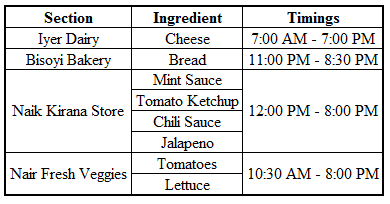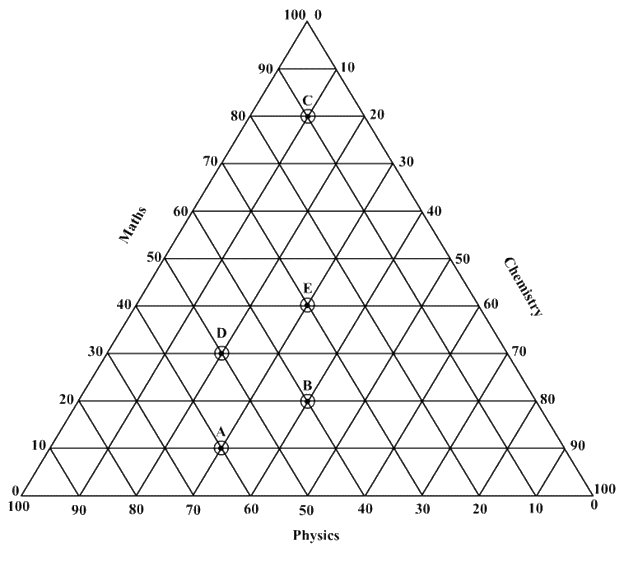DILR Condition Based
Set 2
1. CAT - DILR Condition Based Set 2
Priya takes 15 minutes to select any ingredient. Once the items are selected, the time required to go from one store to another and to get the billing done is negligible. Priya reaches home at 8:30 PM, after buying all the ingredients and traveling back and forth in the minimum possible time. Also,
- Priya bought cheese just before the relevant store closed.
- Mint sauce was not the last product selected at Naik Kirana Store.
- Jalapenos were not selected immediately before Bread or Chilli Sauce.
- Priya kept the gap between selecting tomatoes and tomato ketchup minimum.
- Priya visited each store only once.

Q1. At what time does Priya buy Mint Sauce?
- 6:15 – 6:30 PM
- 7:00 – 7:15 PM
- 8:00 – 8:15 PM
- None
Q2. Which was the fifth ingredient to be selected?
- Tomato Ketchup
- Chili Sauce
- Jalapenos
- Mint Sauce
Q3. What was the time interval (in hours) between the time Priya finished selecting Lettuce and she started buying Chilli Sauce?
- 1
- 1.25
- 0.75
- 0.5
Q4. Priya decided not to adhere to her condition that Tomatoes and Tomato Ketchup had to be purchased within the minimum possible gap. In how many ways could she have completed all her purchases?
Correct Answer 1
d. None
Correct Answer 2
c. Jalapenos
Correct Answer 3
b. 1.25
Correct Answer 4
16
2. CAT - DILR Condition Based Set 2
There are seven students (A, B, C, D, E, F, G) who have decide to read one book out of B1 – B7 and one novel out of N1 – N7 on each day of the week from Monday to Sunday. Exactly one book and one novel is read every day. They read them in two slots- Morning and Evening – on each day. No friend reads the same book or novel twice and only one friend reads on a given day.
- 3 novels were not read in the second slot and exactly two of them were of the same type (odd/even).
- E reads an odd numbered novel and book on Thursday in the first and second slot respectively.
- C and F did not read novels in the first slot during the weekend i.e. on Saturday or Sunday.
- G read B5 in the first slot and N1 in the second slot on Friday.
- A read the same numbered book and novel.
- B2, N5 and N2 were read on alternate days in the same order in the first slot.
- B2, B4 and B3 were read on consecutive days but not necessarily in the same slot nor order.
- On Saturday the difference between the book number and novel number was 5 between the two slots.
- The first novel of the first slot was read on Wednesday and A read N6 on Sunday in the second slot.
- B1 was not read on Monday and D read the highest numbered novel in the first slot
Q1. How many distinct arrangements are possible, considering the people, the books and novels that they read and the days on which they read them?
- 1
- 2
- 8
- CBD
Q2. Who reads N2 and on which day?
- B, Wed
- B, Sat
- D, Wed
- D, Sat
Q3. If F reads on Monday, then who reads N4?
- F
- D
- C
- CBD
Q4. How many books and novels have been read before B1?
- 7
- 5
- 6
- CBD
Correct Answer 1
c. 8
Correct Answer 2
b. B, Sat
Correct Answer 3
d. CBD
Correct Answer 4
a. 7
3. CAT - DILR Condition Based Set 2
There are five parties – A, B, C, D and E – contesting in an election. There is a bet on the probable winner. As per the betting rules, if a person bets on a party and if
- The party wins the elections; the person gets five times the amount bet.
- The party comes second in the elections; the person gets two times the amount bet.
- The party comes third in the elections; the person gets back the exact amount bet.
- If the party comes fourth or fifth, the person forfeits the amount bet.
A person can bet on a maximum of three parties. In the election results, it is known that C came second
Q1. Ashok bets Rs.5,000 on A, Rs. 3,000 on B and Rs. 1,000 on D. In how many ways can A just recover his amount?
Correct Answer 1
0 ways
Correct Answer 2
1st Rank
Correct Answer 3
1080
Correct Answer 4
3
4. CAT - DILR Condition Based Set 2
- Tina’s office is one floor above Sharma’s and two floors above the Reliable Liquid Fund manager’s.
- Mr. Jain isn’t the Reliable Debt Fund manager.
- Kiran and Verma worked for the same mutual fund company before joining Reliable.
- Priyal’s office is one floor above the Reliable Blue Chip Fund office.
- The Reliable Worldwide Fund office is on the floor directly below where Singh has an office.
- Karan, who isn’t Jain, managed the Liquid Fund before moving on last year to the fund he currently manages.
- Verma’s office is one floor below that of the Debt Fund manager.
- Mr. Sharma doesn’t manage the Reliable Sectoral Fund.
- Tahil’s fund isn’t the Reliable Equity.
- The Reliable Sectoral Fund manager has an office one floor above Julie, who is on the floor directly above fellow manager Jain.
- Chopra’s office isn’t the one on the third floor of the Reliable Building
Q1. Who among the following manages the Equity fund?
- Tina
- Priyal
- Kashyap
- Kiran
Q2. Which of the following pairs has the maximum difference in the number of floors in between them?
- Kashyap – Singh
- Tina – Chopra
- Kiran – Chopra
- Kashyap – Tahil
Q3. The Sectoral Fund has its office on which floor of the building
- 5
- 6
- 4
- 3
Q4. What is the square of the sum of the floor numbers of offices of Kiran, Tina and Priyal?
- 36
- 64
- 81
- 100
Correct Answer 1
a. Tina
Correct Answer 2
c. Kiran - Chopra
Correct Answer 3
d. 3
Correct Answer 4
d. 100
5. CAT - DILR Condition Based Set 2
Four friends A, B, C and D played a game of Poker. Initially, the number of chips that they had was in the 60s, 40s, 50s and 70s respectively, such that each one of them had a prime number of chips. They played 6 rounds of game such that the chips were only transferred among them. It is also known that:
- A lost 10 chips in each round and still finally ended up with a prime number of chips.
- The number of chips with B in each round formed an increasing arithmetic progression.
- The chips with D were all the possible numbers between 71 and 77 (both inclusive), but not in any specific order. No number in this range was excluded.
- B ended up with the number of chips that A had at the start of the game.
- The number of chips with D were even after rounds 1, 3 and 5 while the numbers were odd after rounds 2, 4 and 6.
- The number of chips with C after rounds 1 and 4 was a perfect square .
- Both C and D had 74 chips at the end of round 3.
- Everyone except D ended up with a prime number of chips.
Correct Answer 1
240
Correct Answer 2
3 Rounds
Correct Answer 3
Round 2
Correct Answer 4
Round 2
6. CAT - DILR Condition Based Set 2
- Nonie will not go to Shimla unless Sophie goes to Darjeeling and Rosie goes to Kodaikanal.
- Sophie will not go to Kodaikanal unless Princie goes to Mussoorie and Nonie goes to Darjeeling.
- Rosie will not go to Mussoorie unless Nonie goes to Shimla and Sophie goes to Darjeeling.
- Nonie will not go to Darjeeling unless Princie goes to Mussoorie and Rosie goes to Kodaikanal.
- Sophie will not go to Darjeeling unless Nonie goes to Mussoorie and Rosie goes to Kodaikanal.
- Nonie will not go to Mussoorie unless Sophie goes to Shimla and Princie goes to Darjeeling.
- Princie will not go to Mussoorie unless Sophie goes to Shimla and Nonie goes to Kodaikanal.
- Nonie will not go to Kodaikanal unless Sophie goes to Mussoorie and Rosie goes to Shimla.
- Princie will not go to Darjeeling unless Rosie goes to Shimla
- Nonie
- Sophie
- Rosie
- Princie
- Nonie
- Sophie
- Rosie
- Princie
Q3. Sophie could visit which of the following locations?
- Shimla
- Darjeeling
- Mussoorie
- Kodaikanal
- Shimla
- Darjeeling
- Mussoorie
- No possible combination
Correct Answer 1
c. Rosie
Correct Answer 2
d. Princie
Correct Answer 3
c. Mussoorie
Correct Answer 4
d. No possible combination
7. CAT - DILR Condition Based Set 2
- The total number of apples and papayas is the same as number of pomegranates that G has.
- There are ten oranges and guavas put together.
- The total number of papaya and mangoes is eight.
- There a half a dozen apples and oranges in all.
- D has the maximum pieces of fruits.
- The number of fruits with E is not a perfect square.
8. CAT - DILR Condition Based Set 2

Correct Answer 1
52
Correct Answer 2
66.66
Correct Answer 3
40%
Correct Answer 4
20
9. CAT - DILR Condition Based Set 2
- 47
- 3
- 17
- 23
- 10
- 11
- 3
- 8
Correct Answer 1
47
Correct Answer 2
214
Correct Answer 3
c. 17
Correct Answer 4
a. 10
10. CAT - DILR Condition Based Set 2
- 1
- 3
- 7
- 9
- U’s Car
- V’s Car
- S’s Car
- S’s Car
- S’s car is in the second position
- P’s car is in the third position
- V’s car is the second last car
- None of these
- 1 or 3
- 2
- 0 or 3
- 0 or 2
Correct Answer 1
d. 9
Correct Answer 2
a. U’s Car
Correct Answer 3
b. P’s car is in the third position
Correct Answer 4
d. 0 or 2

